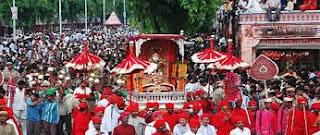Gangour Pooja or story
gaur is colourful and one of the most important festival
Festival of people of Rajasthan and is observed throughout the state with great fervour and devotion by womenfolk who worship Gauri , the wife of Lord shiva during March–April. It is the celebration ofs celebration is now more than 100 years old in Kolkata
गणगौर रंगीन है और राजस्थान के लोगों के सबसे महत्वपूर्ण त्योहारों में से एक है, जो पूरे राज्य में मार्च-अप्रैल के दौरान भगवान शिव की पत्नी गौरी की पूजा करते हैं। यह वसंत, फसल और वैवाहिक निष्ठा का उत्सव है। गण भगवान शिव और गौर का एक पर्याय है जो गौरी या पार्वती के लिए खड़ा है जो सौभय (वैवाहिक आनंद) का प्रतीक है। अविवाहित महिलाएं एक अच्छे पति के साथ आशीर्वाद पाने के लिए उसकी पूजा करती हैं, जबकि विवाहित महिलाएं अपने पति के कल्याण, स्वास्थ्य और लंबे जीवन के लिए करती हैं और एक सुखी वैवाहिक जीवन के लिए। राजस्थान के लोग जब पश्चिम बंगाल में कोलकाता चले गए तो उन्होंने गणगौर मनाना शुरू कर दिया। यह उत्सव अब कोलकाता में 100 वर्ष से अधिक पुराना है
एक बार, भगवान शिव, देवी पार्वती और नारद मुनि के साथ एक छोटी सी यात्रा के लिए निकले। जब वे पास के जंगल में पहुँचे, तो उनके आने की खबर जंगली आग की तरह फैल गई। चूंकि महिलाएं देवी और देवताओं के लिए एक भव्य प्रसार तैयार करने में व्यस्त थीं, इसलिए निम्न वर्ग की महिलाएं उनके लिए प्रसाद लेकर आईं। भगवान शिव और देवी पार्वती ने खुशी से खाना खाया और देवी ने उन पर "सुहागरात" छिड़क दी।
एक निश्चित समय के बाद, उच्च वर्ग की महिलाएं उनके द्वारा तैयार किए गए भोजन के साथ आईं। जब उन्होंने भगवान शिव को खाने के लिए तैयार किया, तो उन्होंने उससे पूछा कि वह महिलाओं को आशीर्वाद देने के लिए क्या कर रही है क्योंकि उसने निम्न वर्ग की महिलाओं को आशीर्वाद देने के लिए "सुहागरात" के पहले ही पूरा कर लिया है। इस पर, देवी पार्वती ने उत्तर दिया कि वह इन महिलाओं को अपने खून से आशीर्वाद देना चाहती हैं। इतना कहते हुए, उसने अपनी उंगली की नोक को खरोंच दिया और इन महिलाओं पर खून छिड़क दिया
त्यौहार होली के अगले दिन, चैत्र के पहले दिन से शुरू होता है और 16 दिनों तक चलता रहता है। एक नवविवाहित लड़की के लिए, त्योहार के 18 दिनों के पूर्ण पाठ्यक्रम का पालन करना बाध्यकारी है जो उसकी शादी को सफल बनाता है। यहां तक कि अविवाहित लड़कियां 18 दिनों की पूरी अवधि के लिए उपवास करती हैं और दिन में केवल एक समय भोजन करती हैं। चैत्र मास के शुक्ल पक्ष के 3 वें दिन उत्सव भस्म। मेले (गणगौर मेले) 18 दिनों की अवधि में आयोजित किए जाते हैं। गणगौर के साथ कई लोककथाएँ जुड़ी हुई हैं, जो इस त्यौहार को राजस्थान, और मध्य प्रदेश, हरियाणा और गुजरात के हिस्सों में गहराई से समाहित करती हैं।
gaur is colourful and one of the most important festival
गणगौर रंगीन है और राजस्थान के लोगों के सबसे महत्वपूर्ण त्योहारों में से एक है, जो पूरे राज्य में मार्च-अप्रैल के दौरान भगवान शिव की पत्नी गौरी की पूजा करते हैं। यह वसंत, फसल और वैवाहिक निष्ठा का उत्सव है। गण भगवान शिव और गौर का एक पर्याय है जो गौरी या पार्वती के लिए खड़ा है जो सौभय (वैवाहिक आनंद) का प्रतीक है। अविवाहित महिलाएं एक अच्छे पति के साथ आशीर्वाद पाने के लिए उसकी पूजा करती हैं, जबकि विवाहित महिलाएं अपने पति के कल्याण, स्वास्थ्य और लंबे जीवन के लिए करती हैं और एक सुखी वैवाहिक जीवन के लिए। राजस्थान के लोग जब पश्चिम बंगाल में कोलकाता चले गए तो उन्होंने गणगौर मनाना शुरू कर दिया। यह उत्सव अब कोलकाता में 100 वर्ष से अधिक पुराना है
एक बार, भगवान शिव, देवी पार्वती और नारद मुनि के साथ एक छोटी सी यात्रा के लिए निकले। जब वे पास के जंगल में पहुँचे, तो उनके आने की खबर जंगली आग की तरह फैल गई। चूंकि महिलाएं देवी और देवताओं के लिए एक भव्य प्रसार तैयार करने में व्यस्त थीं, इसलिए निम्न वर्ग की महिलाएं उनके लिए प्रसाद लेकर आईं। भगवान शिव और देवी पार्वती ने खुशी से खाना खाया और देवी ने उन पर "सुहागरात" छिड़क दी।
एक निश्चित समय के बाद, उच्च वर्ग की महिलाएं उनके द्वारा तैयार किए गए भोजन के साथ आईं। जब उन्होंने भगवान शिव को खाने के लिए तैयार किया, तो उन्होंने उससे पूछा कि वह महिलाओं को आशीर्वाद देने के लिए क्या कर रही है क्योंकि उसने निम्न वर्ग की महिलाओं को आशीर्वाद देने के लिए "सुहागरात" के पहले ही पूरा कर लिया है। इस पर, देवी पार्वती ने उत्तर दिया कि वह इन महिलाओं को अपने खून से आशीर्वाद देना चाहती हैं। इतना कहते हुए, उसने अपनी उंगली की नोक को खरोंच दिया और इन महिलाओं पर खून छिड़क दिया
त्यौहार होली के अगले दिन, चैत्र के पहले दिन से शुरू होता है और 16 दिनों तक चलता रहता है। एक नवविवाहित लड़की के लिए, त्योहार के 18 दिनों के पूर्ण पाठ्यक्रम का पालन करना बाध्यकारी है जो उसकी शादी को सफल बनाता है। यहां तक कि अविवाहित लड़कियां 18 दिनों की पूरी अवधि के लिए उपवास करती हैं और दिन में केवल एक समय भोजन करती हैं। चैत्र मास के शुक्ल पक्ष के 3 वें दिन उत्सव भस्म। मेले (गणगौर मेले) 18 दिनों की अवधि में आयोजित किए जाते हैं। गणगौर के साथ कई लोककथाएँ जुड़ी हुई हैं, जो इस त्यौहार को राजस्थान, और मध्य प्रदेश, हरियाणा और गुजरात के हिस्सों में गहराई से समाहित करती हैं।










